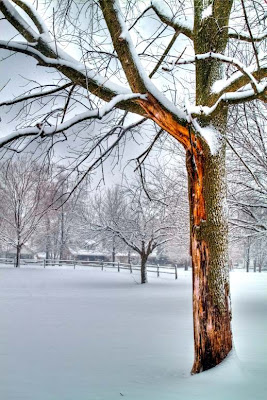A year ago yesterday, Central Indiana was hit with a snowstorm that dropped 7 or so inches. I grabbed some pictures of the snowfall in Garfield Park in Indianapolis that day and posted them here the following Monday. The day after the snowfall, we had brilliant sunshine, and so I went back out and got followup images, using a polarizing filter to soak in those rich blue sky colors, and posted those pictures here, too.
On yesterday's first anniversary of that 2010 snowfall, we got another 3-4 inches of snow in Central Indiana (which was on top of Monday night/Tuesday's ice storm, and many people still haven't cleared the 1.5 inches of ice from that off sidewalks). So I decided to use the snowfall to make my first serious foray into high-dynamic range (HDR) work the traditional way -- multiple-exposure bracketing and then combining the multiple images into a single frame to take advantage of the scene's lightest lights, darkest darks and richest midtones. My reference to "the traditional way" was meant to distinguish this process from the built-in, frame-combining HDR feature that some compact cameras (including my PowerShot G12) do automatically for you.
Like in most technology, HDR is a trendy application of photography. I'm actually coming into it late in the game; the theory (and even practice, in painstaking ways) has been out there for decades, dating back to film. The availability of software capitalizing on just this facet of photography has proliferated in just the past couple years. In addition to being able to exploit the exposure highlights throughout the range of a contrasty image, HDR tends to transcend the look of an image from photograph to a piece of fine art, for lack of a better term. I add the qualifier because many photographers will contend -- with good reason, I feel -- that a traditional image is already fine art ... and doesn't (or shouldn't) need to be altered much in post-processing.
It's because of that that I've avoided dabbling in HDR work until now; I've seen a lot of over-the-top HDR indulgence that I did not find particularly appealing. But I do understand -- and appreciate -- the benefits of getting the maximum detail out of a scene if A) you truly believe it's photogenic, and B) contrasty lighting conditions preclude you from being able to capture its essence in a single frame. Plus, I've seen many people react dramatically -- and in a positive way -- when viewing an image treated heavily in Photoshop or other such post-processing software programs, so ... I feel it should be left to each viewer to decide what he or she considers fine art, not me ... or any other single individual.
So today's post are the results of my first shoot devoted entirely to exploring HDR work. I spent about about an hour in the park, taking three three differently exposed images of each scene and later combining them into one. For the shoot, I used my Canon 7D and Tamron 28-75mm f/2.8 lens. Constants for the shoot were the shooting mode (aperture-priority, either f/8 or f/11), ISO (100), white balance (cloudy/overcast) and the camera was mounted on a tripod. The variable for the bracketing, consequently, was the shutter speed. Images were processed initially in Photoshop Elements 7, with the frame-combining HDR work done in Photomatix 4.0.
The image at the top is the MacAllister Center for the Performing Arts, with the snowfall readily apparent against the amphitheater's stage area. I did darken the shadows slider on this image to bring better detail to the snowfall; for most of the other shots, I did very little in Photoshop other than to convert DNG files to JPG before the images were processed for HDR in Photomatix.
Above: The pedestrian path east of the MacAllister amphitheater, looking north from the pedestrian roundabout.
Above and the two images below: From the playground immediately south of the Garfield Park pagoda. The specks in the sky are not dust spots on the sensor; those are three-image-layers' worth of snowflakes.
Above: The east facade of the Garfield Park pagoda, where lengthy icicles from the ice storm four days earlier are still evident.
Above and below: Closeups of separate sections of those icicles from the pagoda's east facade.
Above and below: Two angles of a gentleman who apparently came to the park this day to think or meditate. If he was looking for isolation, it was a good day to to visit the park. There was sparse vehicular traffic, but he and I were the only foot traffic I noticed until I made my way home, when I noticed another person out walking a dog.
Above: The sidewalk extending south from the pagoda toward the playground area.
Above: The Garfield Park Arts Center, looking north and slightly west.
Above: Another frame of the MacAllister amphitheater layout, only this time with natural lighting ... and a focus more on the seating pattern.




















No comments:
Post a Comment